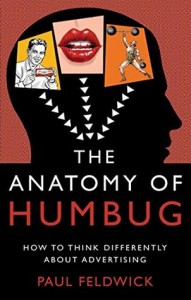Thanks to relatively new research in the effectiveness of advertising, which pits fact-based information messages against emotion-based non-propositional messages, I see a unique opportunity to strengthen the creative brief in general, and the proposition in particular.
No matter which side of this debate wins, and there’s a decent chance that both will end up playing equal parts, the creative brief is not going away.
All communication projects require a roadmap, a set of directions, some kind of objectives document that sets the standard by which we can assess the work.
My passion is the brief. In particular, it is about bringing clarity to the brief. Clarity that drives inspired work.
So here is what I have learned. It’s heady stuff, filled with academic jargon. I will summarize in clear English:
About eight years ago, two advertising researchers, Paul Feldwick, a veteran account planner and author of the book, The Anatomy of Humbug: How To Think Differently About Advertising, and Dr. Robert Heath from the University of Bath School of Management, published a scholarly article in the International Journal of Marketing Research in which they argued that the existing model for advertising does not work. They titled their piece, “50 years using the wrong model of advertising.” 
This model, called Information Processing (IP), is premised on the idea that people make decisions based on reason and information, and that effective advertising conveys facts about a brand.
In other words, good information equals good advertising. Consumers, who act rationally, will respond to this advertising, or so the argument goes.
Feldwick and Heath disagree and offered an alternative. They argued that emotion, rather than facts or reason, drives consumer decision making and is therefore a more effective tool for building brands. They believe that consumers make decision based on their emotions, not reason. They called this model Critical Realism.
In one enlightening example, Professor Heath and colleagues tested 43 TV spots (23 aired in the US, 20 aired in the UK) for their emotional and rational content. The authors presented impressive, empirical, statistically significant evidence to support their position in 2006. Even with different advertising styles in the US and the UK, their results were consistent:
…the experimental results show clearly that it is the emotional ‘creative’ content in advertising that builds (brand) favourability, not the rational message. This again contradicts the idea in the information processing model that it is the communication of the factual message that gives advertising its power.
What is the implication for the creative brief?
Here is what the authors say:
…creative departments will have to abandon their obsession with simple, functional briefs and creating ‘impact’ , in favour of creativity that influences emotions and brand relationships — which in truth is what the best creative work has always done, normally in spite of prevailing theory rather than because of it.
From the day I began writing about the creative brief in 2008, I repeated one thing over and over: the brief is only a template and must adapt to circumstances. That remains true today. In spite of Feldwick and Heath’s recommendation, there is still an important role for the creative brief in this (not so) new world of advertising.
And I can’t help but think that the unique-selling proposition, or single-minded proposition, also still has a role on the brief and in sparking the advertising that arises from it. Except that it, too, must adapt to be effective.
Ergo, I submit that the proposition is dead.
Long live the proposition.
An updated proposition, that is.
Call it the unique emotional proposition—UEP.
This should be music to creatives’ ears. Let me explain my thinking, which, admittedly, contradicts some of what I wrote in last week’s post.
What Feldwich and Heath are proposing is a reliance on a message-less advertisement. Or to use their words, a communication without a proposition. One that can be taken in subconsciously, below the level of awareness.
If you’re too young to remember cigarette commercials on television, here is a classic example: The Marlboro Man. This spot has no proposition, yet it communicates quite clearly.
https://www.youtube.com/watch?v=yQmpqvoEpws
This idea may strike fear in the hearts of analytical corporate America, but Feldwick and Heath have strong evidence that ads that function on this level are effective. More effective than ads grounded on information.
Their research, along with that of many others, offers a strong argument for a new kind of proposition. A proposition based far more on an emotional relationship between brand and consumer. Perhaps entirely on this emotional relationship. 
But if you are a creative, this is simply the day-to-day reality in a typical creative department. Creatives understand the nature of the emotional relationship between a brand and a loyal user.
The creative brief is still the vital first step in the creative process. It must provide the framework within which creatives can operate and establish a standard against which the creative work is assessed.
So the proposition, whether it’s information based or emotion based, must set up this framework. That is the job of the brief.
Here, then, is my three-step prescription for strengthening the proposition—the Unique Emotional Proposition—so that it can function on the higher level of an emotional relationship.
1. The proposition must evoke a feeling.
This may sound obvious, but it must be stated clearly and up front.
We know that consumers make decisions based on how they feel about a product, not based on what they think about it. The proposition should reflect this truth.
2. The proposition must provoke behavior.
Typically, a brief would ask these questions: What do we want the target to think? What do we want the target to feel? What do we want the target to do? 
Strike the first question. Only the second and third questions are relevant.
When consumers have a positive emotional reaction to the product or service, only then does brand loyalty emerge.
3. An emotion-based proposition requires the right VERB.
I have written on this subject before. Verbs are the John Wayne of words. They describe action. Consumers act when they feel a connection to a product: They like it. They love it. The product makes them feel something the did not feel before. This is the power of brands.
The proposition sparks creative ideas when you choose the right verb to express the desired action and the desired emotion.
Assure your brand’s power by writing a proposition with a strong call to action.
Whether you fall into the camp that believes in information-based advertising that assumes a rational consumer or emotion-based advertising that assumes a consumer driven by her feelings, one thing is certain: Your creative brief must be clear. And your proposition must compel the creatives toward solutions that drive action.
I am convinced that infusing the proposition with emotions and emotional sparks will result in better creative solutions.
Long live the Unique Emotional Proposition.

